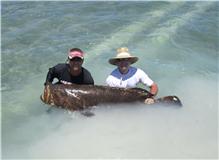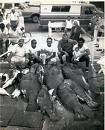|
|
COMING TO GO GOLIATH GROUPER FISHING, YOU BETTER EAT YOUR WHEATIES.
Habitat Occurring in shallow, inshore waters to depths of 150 feet (46 m), the goliath grouper prefers areas of rock, coral, and mud bottoms. Strikingly patterned juveniles inhabit mangroves and brackish estuaries, especially near oyster bars. The goliath grouper is notable as one of the few groupers found in brackish waters. This fish is solitary by nature, with the adults occupying limited home ranges. It is territorial near areas of refuge such as caves, wrecks, and ledges, displaying an open mouth and quivering body to intruders. Additional warning may be delivered in the form of the goliath grouper's ability to produce a distinctly audible rumbling sound generated by the muscular contraction of the swim bladder. This sound travels great distances underwater and is also used to locate other goliath grouper.
Distinctive Features
Size, Age, and Growth The oldest verifiable goliath grouper on record is 37 years. However, this specimen was sampled from a population of individuals depressed by fishing pressure and it is projected that goliath grouper may live much longer, perhaps as much as 50 years. Males achieve sexual maturity at four to six years of age and lengths of 43-45 inches (110-115 cm), females at six to seven years of age and 47-53 inches (120-135 cm). Growth rates are slow, averaging approximately four inches (10 cm) per year until the age of six years. Growth declines to about 1.2 inches (3 cm) per year at age 15, and less than .4 inches (1 cm) per year after 25 years.
Danger to Humans Very large goliath grouper have been observed to stalk divers and even conduct unsuccessful ambushes of the same. Large individuals of this species should be treated with caution.
Food Habits
Spawning occurs during the summer months of July, August, and September throughout the goliath grouper's range
and is strongly influenced by the lunar cycle. Spawning goliath grouper form impressive offshore aggregations of up to 100
or more individuals. Ship wrecks, rock ledges, and isolated patch reefs are preferred spawning habitat. In the 1980's these
aggregations reached a low of less than 10 individuals per site as fishing pressure greatly impacted this species. Since receiving
legislative protection the spawning aggregations of goliath grouper have risen to 20-40 individuals per location. The females
release eggs while the males release sperm into the open offshore waters. After fertilization, the eggs are pelagic, dispersed
by the water currents. Upon hatching, the larvae are kite-shaped, with the second dorsal-fin spine and pelvic fin spines greatly
elongated. These pelagic larvae transform into benthic juveniles at lengths of one inch (2.5 cm), around 25 or 26 days after
hatching.
|
Enter supporting content here





